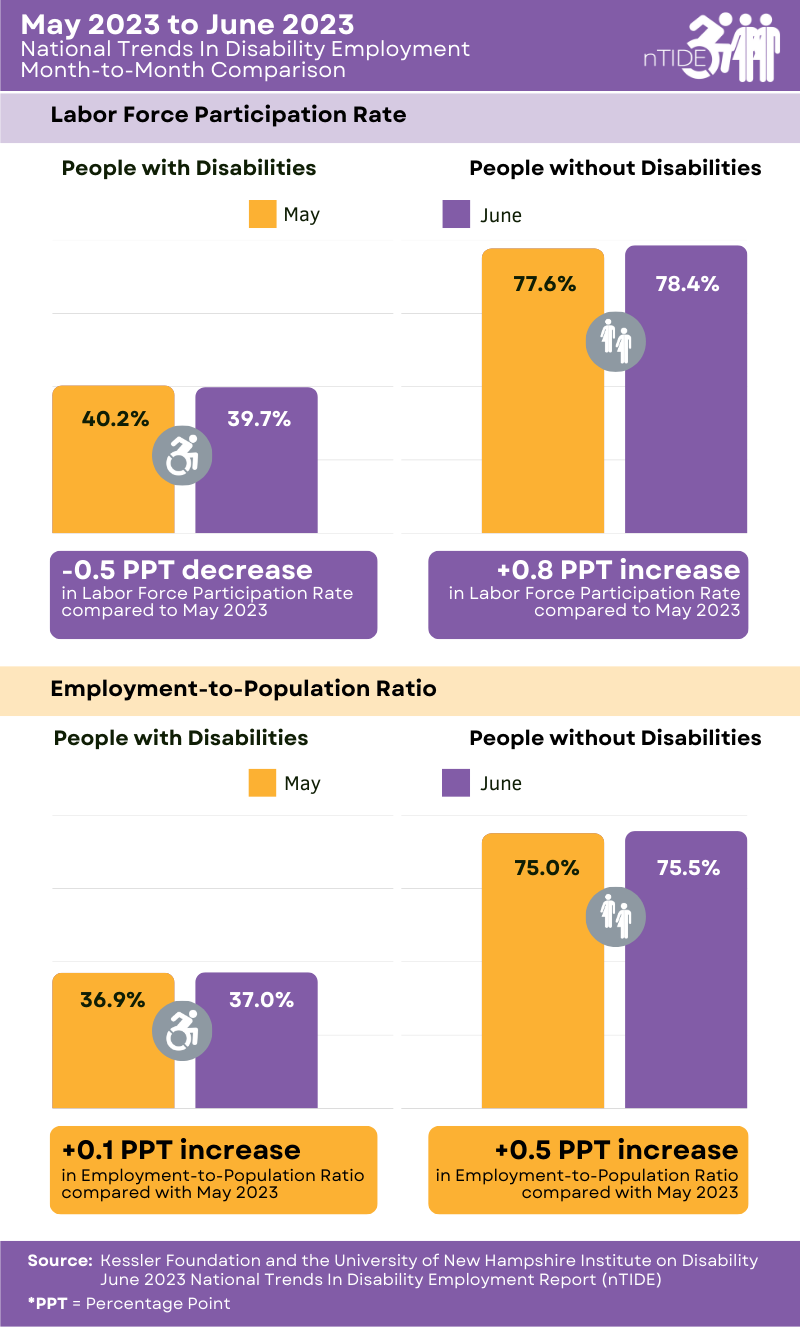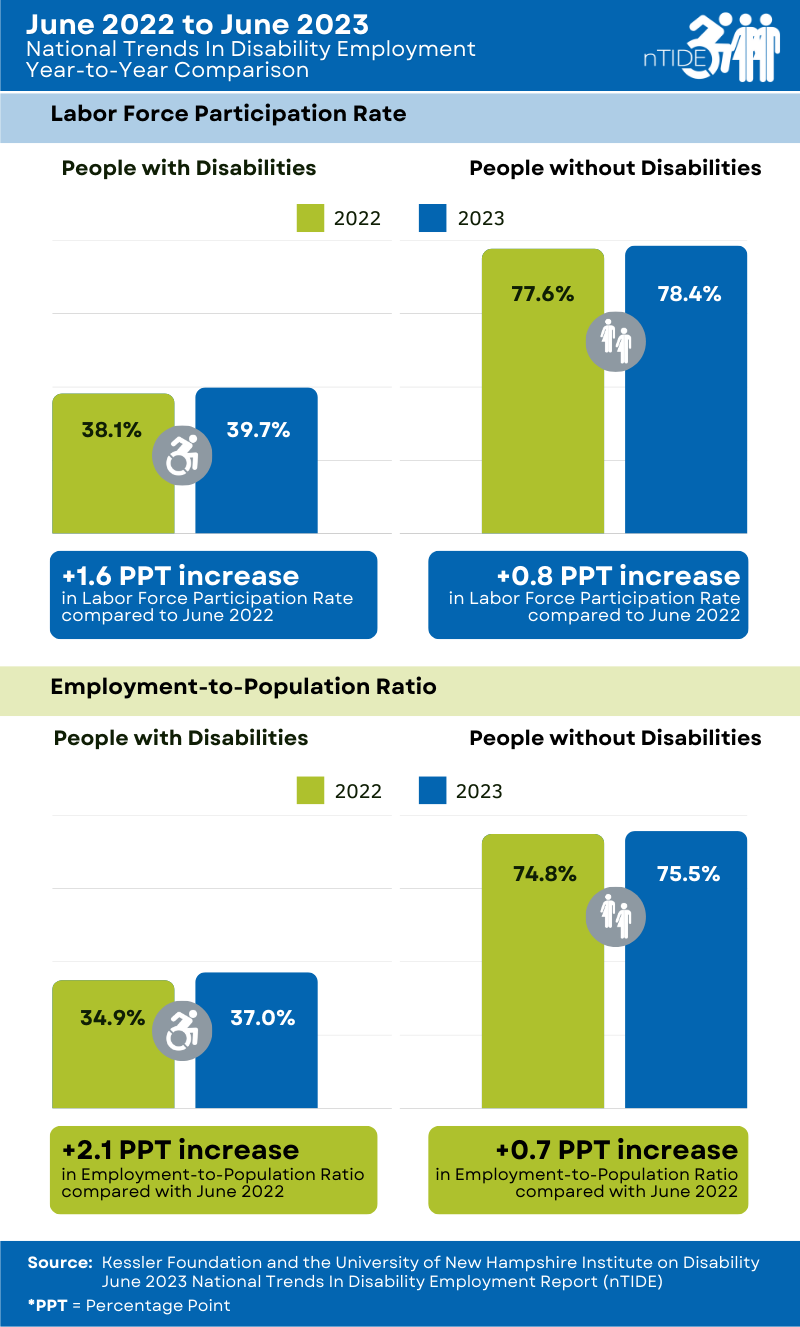National Trends in Disability Employment (nTIDE) – Issued semi-monthly by Kessler Foundation and the University of New Hampshire
East Hanover, NJ – July 7, 2023 – June’s job numbers remained around all-time highs for people with disabilities, according to today’s National Trends in Disability Employment – semi-monthly update (nTIDE), issued by Kessler Foundation and the University of New Hampshire’s Institute on Disability (UNH-IOD). nTIDE experts cautioned that employment of people with disabilities may be negatively affected by further anti-inflationary efforts by the Federal Reserve.
nTIDE Month-to-Month Comparison of Labor Market Indicators for People with and without Disabilities

employment-to-population ratio for people with and without disabilities. The labor force participation rate
declined slightly for people with disabilities and increased for people without disabilities.
Month-to-Month nTIDE Numbers (comparing May 2023 to June 2023)
Based on data from the U.S. Bureau of Labor Statistics (BLS) Jobs Report released today, the employment-to-population ratio for people with disabilities (ages 16-64) increased very slightly from 36.9 percent in May 2023 to 37.0 percent in June 2023 (up 0.3 percent or 0.1 percentage points). For people without disabilities (ages 16-64), the employment-to-population ratio also increased from 75.0 percent in May 2023 to 75.5 percent in June 2023 (up 0.7 percent or 0.5 percentage points). The employment-to-population ratio, a key indicator, reflects the percentage of people who are working relative to the total population (the number of people working divided by the number of people in the total population multiplied by 100).
“The employment-to-population ratio for people with disabilities is hovering around historic highs. We see a similar pattern for those without disabilities, where the ratio remained virtually the same as last month,” said John O’Neill, PhD, director of the Center for Employment and Disability Research at Kessler Foundation. “This pattern suggests that the Federal Reserve’s efforts to slow the labor market to curb inflation may be having the desired effect on people with and without disabilities.”
Regarding labor force participation, the labor force participation rate for people with disabilities (ages 16-64) decreased from 40.2 percent in May 2023 to 39.7 percent in June 2023 (down 1.2 percent or 0.5 percentage points). For people without disabilities (ages 16-64), the labor force participation rate increased from 77.6 percent in May 2023 to 78.4 percent in June 2023 (up 1 percent or 0.8 percentage points). The labor force participation rate reflects the percentage of people who are in the labor force (working, on temporary layoff, on furlough, or actively looking for work in the last four weeks) relative to the total population (the number of people in the labor force divided by the number of people in the total population multiplied by 100).
“In future months, the Federal Reserve is likely to take further action to reduce inflation, which may negatively affect the employment and labor force participation of people with disabilities,” reported Andrew Houtenville, PhD, professor of economics and research director of the UNH-IOD.

with and without disabilities.
Year-to-Year nTIDE Numbers (comparing June 2022 to June 2023)
Compared to the same month last year, the labor force participation rate for people with disabilities (ages 16-64) increased from 38.1 percent in June 2022 to 39.7 percent in June 2023 (up 4.2 percent or 1.6 percentage points). For people without disabilities (ages 16-64), the labor force participation rate also increased from 77.6 percent in June 2022 to 78.4 percent in June 2023 (up 1 percent or 0.8 percentage points).
Similarly, the employment-to-population ratio for working-age people with disabilities (ages 16-64) increased from 34.9 percent in June 2022 to 37 percent in June 2023 (up 6 percent or 2.1 percentage points). For working-age people without disabilities, the employment-to-population ratio also increased from 74.8 percent in June 2022 to 75.5 percent in June 2023 (up 0.9 percent or 0.7 percentage points).
In June, among workers ages 16-64, the 6,250,000 workers with disabilities represented 4.1 percent of the total 150,910,000 workers in the U.S.
Ask Questions about Disability and Employment
Each nTIDE release is followed by an nTIDE Lunch & Learn online webinar. This live broadcast, hosted via Zoom Webinar, offers attendees Q&A on the latest nTIDE findings, provides news and updates from the field, and features invited panelists who discuss current disability-related findings and events.
On July 7, 2023, at 12:00 pm Eastern, Stephanie Enyart, JD, chief public policy and research officer at the American Foundation for the Blind, joins Drs. O’Neill and Houtenville, and Denise Rozell from the Association of University Centers on Disabilities (AUCD). Join our free Lunch & Learn live or visit the nTIDE archives at: ResearchonDisability.org/nTIDE.
Also, register now for our mid-month Deeper Dive into employment trends at nTIDE Deeper Dive - 7/21/2023.
NOTE: The statistics in the nTIDE are based on BLS numbers but are not identical. They are customized by UNH to combine the statistics for men and women of working age (16- 64). nTIDE is funded by Kessler Foundation and was initially funded by grants from the National Institute on Disability, Independent Living and Rehabilitation Research (NIDILRR) (90RT5037).
About nTIDE Updates
National Trends in Disability Employment (nTIDE) is a joint project of Kessler Foundation and the University of New Hampshire Institute on Disability. The nTIDE team closely monitors the job numbers, issuing semi-monthly reports that track the impact of economic shifts on employment for people with and without disabilities. As the effect of the COVID-19 pandemic continues to wane and inflation persistently rises, the nTIDE team has superseded its mid-month COVID Update to a “Deeper Dive” into the BLS data for people with disabilities.
About the Institute on Disability at the University of New Hampshire
The Institute on Disability at the University of New Hampshire was established in 1987 to provide a university-based focus for the improvement of knowledge, policies, and practices related to the lives of persons with disabilities and their families. For information on the Intitute’s NIDILRR-funded Rehabilitation Research and Training Center on Disability Statistics and Demographics (StatsRRTC), visit ResearchOnDisability.org
About Kessler Foundation
Kessler Foundation, a major nonprofit organization in the field of disability, is a global leader in rehabilitation research. Our scientists seek to improve cognition, mobility, and long-term outcomes, including employment, for adults and children with neurological and developmental disabilities of the brain and spinal cord including traumatic brain injury, spinal cord injury, stroke, multiple sclerosis, and autism. Kessler Foundation also leads the nation in funding innovative programs that expand opportunities for employment for people with disabilities.